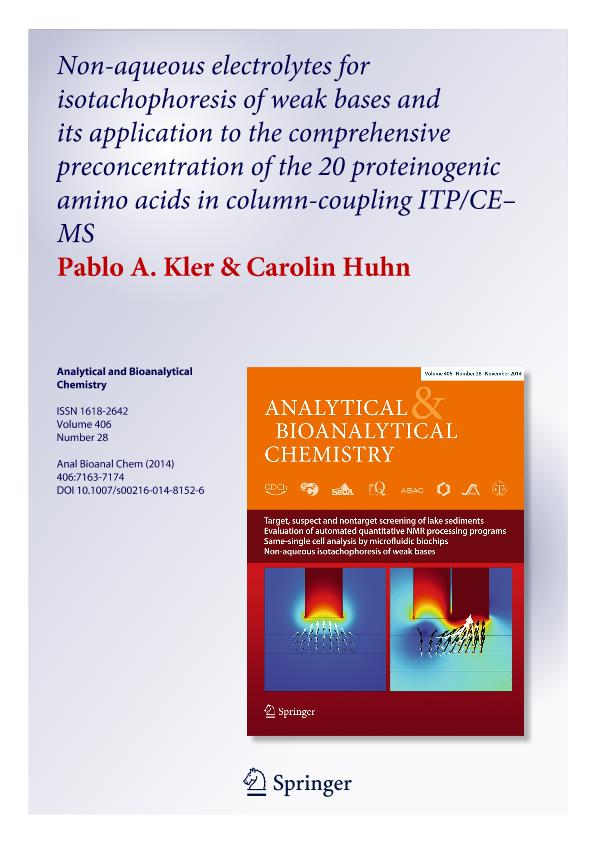Mostrar el registro sencillo del ítem
dc.contributor.author
Kler, Pablo Alejandro

dc.contributor.author
Huhn, Carolin
dc.date.available
2017-07-04T21:27:54Z
dc.date.issued
2014-11
dc.identifier.citation
Kler, Pablo Alejandro; Huhn, Carolin; Non-aqueous electrolytes for isotachophoresis of weak bases and its application to the comprehensive preconcentration of the 20 proteinogenic amino acids in column-coupling ITP/CE-MS; Springer Heidelberg; Analytical and Bioanalytical Chemistry; 406; 28; 11-2014; 7163-7174
dc.identifier.issn
1618-2642
dc.identifier.uri
http://hdl.handle.net/11336/19555
dc.description.abstract
Isotachophoresis (ITP) has long been used alone but also as a preconcentration technique for capillary electrophoresis (CE). Unfortunately, up to now, its application is restricted to relatively strong acids and bases as either the degree of (de)protonation is too low or the water dissociation is too high, evoking zone electrophoresis. With the comprehensive ITP analysis of all 20 proteinogenic amino acids as model analytes, we, here, show that non–aqueous ITP using dimethylsulfoxide as a solvent solves this ITP shortcoming. Dimethylsulfoxide changes the pH regime of analytes and electrolytes but, more importantly, strongly reduces the proton mobility by prohibiting hydrogen bonds and thus, the so-called Zundel–Eigen–Zundel electrical conduction mechanism of flipping hydrogen bonds. The effects are demonstrated in an electrolyte system with taurine or H+ as terminator, and imidazole as leader together with strong acids such as oxalic and even trifluoroacetic acid as counterions, both impossible to use in aqueous solution. Mass spectrometric as well as capacitively coupled contactless conductivity detection (C4D) are used to follow the ITP processes. To demonstrate the preconcentration capabilities of ITP in a two-dimensional set-up, we, here, also demonstrate that our non-aqueous ITP method can be combined with capillary electrophoresis–mass spectrometry in a column-coupling system using a hybrid approach of capillaries coupled to a microfluidic interface. For this, C4D was optimized for on-chip detection with the electrodes aligned on top of a thin glass lid of the microfluidic chip.
dc.format
application/pdf
dc.language.iso
eng
dc.publisher
Springer Heidelberg

dc.rights
info:eu-repo/semantics/openAccess
dc.rights.uri
https://creativecommons.org/licenses/by-nc-sa/2.5/ar/
dc.subject
Non-Aqueous Isotachophoresis
dc.subject
Itp/Ce-Ms
dc.subject
Weak Bases
dc.subject
Amino Acids
dc.subject
Capacitively Coupled Contactless Conductivity Detection
dc.subject.classification
Química Analítica

dc.subject.classification
Ciencias Químicas

dc.subject.classification
CIENCIAS NATURALES Y EXACTAS

dc.title
Non-aqueous electrolytes for isotachophoresis of weak bases and its application to the comprehensive preconcentration of the 20 proteinogenic amino acids in column-coupling ITP/CE-MS
dc.type
info:eu-repo/semantics/article
dc.type
info:ar-repo/semantics/artículo
dc.type
info:eu-repo/semantics/publishedVersion
dc.date.updated
2017-07-03T19:51:39Z
dc.journal.volume
406
dc.journal.number
28
dc.journal.pagination
7163-7174
dc.journal.pais
Alemania

dc.journal.ciudad
Berlín
dc.description.fil
Fil: Kler, Pablo Alejandro. Consejo Nacional de Investigaciones Científicas y Técnicas. Centro Científico Tecnológico Conicet - Santa Fe. Centro de Investigaciones En Metodos Computacionales. Universidad Nacional del Litoral. Centro de Investigaciones En Metodos Computacionales; Argentina. Universidad Eberhard Karls. Faculty of Science. Institute of Physical and Theoretical Chemistry; Alemania
dc.description.fil
Fil: Huhn, Carolin. Universidad Eberhard Karls. Faculty of Science. Institute of Physical and Theoretical Chemistry; Alemania
dc.journal.title
Analytical and Bioanalytical Chemistry

dc.relation.alternativeid
info:eu-repo/semantics/altIdentifier/url/http://link.springer.com/article/10.1007/s00216-014-8152-6
dc.relation.alternativeid
info:eu-repo/semantics/altIdentifier/doi/http://dx.doi.org/10.1007/s00216-014-8152-6
Archivos asociados
